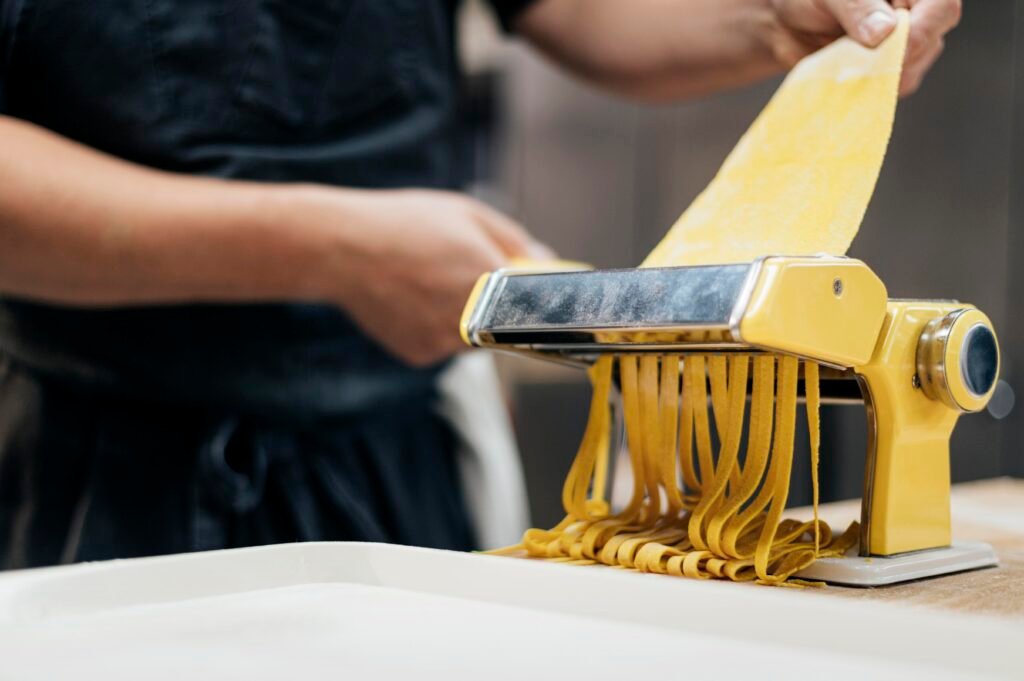A Tortellinatrice is a pasta forming machine designed to make tortellini quickly, consistently, and with their traditional Italian shape. The machine rolls a sheet of dough, adds filling, folds, and seals each piece so it is ready to cook or package. In the past, tortellini were made by hand, but with the tortellinatrice, both small kitchens and large factories can produce fresh pasta with far less effort. This device connects Italian culinary tradition with modern food technology, making authentic tortellini accessible worldwide.
Understanding the Tortellinatrice
What the Tortellinatrice Really Does
At its core, the tortellinatrice is a specialized pasta machine. It automates the same careful steps Italian grandmothers once performed at the kitchen table. Dough sheets move into the device, a precise amount of filling is added, then the sheet is folded and pressed into the signature ring shape. The result is a uniform row of tortellini, ready to be cooked or frozen.
This process allows hundreds of pieces to be produced in minutes, a task that would take hours by hand. Consistency is one of its greatest strengths, since every piece is sealed and shaped evenly.
Why the Tortellinatrice Matters
The machine matters because it expands access to fresh pasta. For centuries, tortellini was tied to Emilia Romagna, where it was made fresh in homes and a few shops. Today, thanks to the tortellinatrice, tortellini can be enjoyed in restaurants, supermarkets, and home kitchens across the world without losing authenticity.
It also gives chefs freedom to experiment. Because fillings can be changed quickly, kitchens can offer new recipes with ease, from classic meat blends to modern flavors like pumpkin with nutmeg or mozzarella with basil.
The Origins and Evolution
From Nonna’s Hands to Modern Machines
Traditionally, tortellini was hand-folded. Each piece required patience, skilled fingers, and years of practice. While this method was full of love, it also limited how much could be produced. Families made enough for gatherings, but restaurants and shops needed more.
Around the middle of the 20th century, Italian food innovators and technicians developed machines to automate the folding of tortellini, responding to growing demand in restaurants and food factories.
Early versions were large and meant for factories. Over time, improved designs reached artisan shops and later home kitchens. This journey mirrors Italian cuisine as a whole, where technology supports tradition instead of replacing it.
A Symbol of Tradition and Innovation
The tortellinatrice symbolizes how tradition and modern progress can work together, preserving Italian culture while embracing efficiency. It does not erase the artistry of handmade pasta but allows more people to enjoy authentic flavors. For Italians abroad, it preserves cultural identity. For chefs worldwide, it opens the door to serve true tortellini alongside creative twists.
Anatomy of a Tortellinatrice
Key Components
Though models differ, most machines include the same essential parts:
Dough feeder guides the pasta sheet into the machine.
Filling injector adds the right amount of stuffing.
Shaping rollers fold the dough over the filling.
Cutting mechanism trims the edges and forms the tortellini shape.
Industrial machines may also include conveyors and scrap removal systems, while home versions are simpler, sometimes manual with cranks or small motors.
Manual vs Electric
Manual models are affordable and suit families or hobby cooks. They require turning a crank and give users more control. Electric or semi-automatic models are better for restaurants and factories where speed and volume matter most. Both aim for perfect tortellini, but their scale differs.
Using a Tortellinatrice
Ease of Use
Although the machine may look complex, most tortellinatrice models are easy to use. Instructions guide users through placing dough, filling, and operating rollers. Home cooks often only need to press a button or turn a handle. The real challenge lies in the dough. If the dough is too dry or thick, it resists shaping. If it is too wet, it sticks and tears. With practice, users find the balance.
Tips for Success
Use dough that has been rested and rolled evenly. Choose fillings that are smooth but not watery. Clean the machine when switching fillings, since residue can prevent proper sealing. With practice, the process feels natural and efficient, much like the tradition it modernizes.
Benefits of a Tortellinatrice
Speed and Efficiency
The tortellinatrice saves time. Tasks that once took hours now take minutes. Restaurants can serve more guests, families can prepare meals on busy nights, and factories can distribute worldwide.
Consistency and Quality
It produces uniform pieces with identical size and shape, which means they all cook evenly and taste consistent. This consistency is essential for packaged products and restaurants that rely on uniform results.
Reduced Waste
By controlling dough thickness and filling size, the machine reduces waste. Fewer broken pieces and less discarded dough mean lower costs and better ingredient use.
Creativity and Joy
The machine encourages creativity. Chefs can test new fillings, home cooks can experiment with flavored doughs, and families can make pasta nights fun and interactive. The machine turns pasta-making into more than food preparation, offering both nourishment and a joyful experience for families and chefs.
Beyond Tortellini, Other Pasta Formats
While made for tortellini, many machines can produce other filled pasta. This makes them versatile for kitchens and shops.
Ravioli are square or rectangular pasta pillows.
Agnolotti are half-moon shaped pasta from Piedmont.
Cappelletti, a traditional pasta from northern Italy, are shaped like tiny hats and are often enjoyed in broths or light sauces.
This flexibility adds value, especially for businesses that want variety without buying multiple machines.
Choosing Fillings for the Tortellinatrice
Classic Options
Beloved traditional fillings include ricotta with spinach, ground pork with parmesan, and pumpkin with nutmeg. These time-honored flavors work well with the machine’s dosing system.
Creative Flavors
Modern cooks use seafood, truffle creams, or vegetable mixes. International ideas like goat cheese with herbs or roasted peppers also work well, as long as the filling has a smooth texture.
Families, Children, and the Tortellinatrice
The tortellinatrice is not only for professionals. With supervision, children can help with simple steps like loading dough or turning a crank. The process is hands-on, fun, and educational. It teaches patience, cooking skills, and the satisfaction of eating something you created. This turns an ordinary dinner into a family memory.
Where to Buy and What to Expect
Tortellinatrice models can be found in kitchenware stores, Italian specialty shops, and online platforms. Home versions cost between 100 and 300 dollars, while commercial machines can cost several thousand depending on size and automation. Choosing depends on your purpose: occasional family meals, daily restaurant production, or large-scale supply.
Reading reviews, comparing options, and checking spare part availability helps ensure a smart purchase. When maintained properly, a high-quality tortellinatrice can remain reliable for many years, making it a lasting investment.
Downsides and Challenges
The tortellinatrice is not perfect. Quality machines can be expensive. Larger models take up significant space. Users also face a learning curve, since dough and fillings must be adjusted for the best results. Still, the benefits usually outweigh these issues, especially for anyone serious about making fresh pasta.
Impact on the Food Industry
The tortellinatrice has transformed professional kitchens and pasta factories. It allows cooks to produce more without hiring large teams, making fresh pasta available to more people. This efficiency helps stabilize prices and keeps pasta traditions alive even in global markets far from Italy.
Global Reach and Cultural Exchange
Tortellini is no longer limited to Emilia Romagna. Thanks to the tortellinatrice, it is now common in New York, Tokyo, Sydney, and beyond. Chefs experiment with fillings that reflect their own cultures while respecting the Italian shape, creating unique fusion dishes. The tortellinatrice spreads Italian identity across the globe.
The Future of the Tortellinatrice
Future models will be smarter and more sustainable. We can expect digital controls, automatic filling detection, and even app integration.
Future designs may include eco-friendly features like low-energy motors and recyclable materials to support sustainability. The goal will remain the same, to honor tradition while meeting modern needs.
Conclusion
The Tortellinatrice is more than a machine. It is a bridge between tradition and technology, turning hours of careful folding into minutes of consistent shaping. The tortellinatrice makes fresh pasta available across the globe, protecting Italian culinary heritage while inspiring creative dishes in kitchens everywhere. Whether in a small family home or a large factory, the tortellinatrice carries forward the spirit of pasta-making, where simple ingredients, care, and love come together to create something unforgettable.
Frequently Asked Questions ( FAQs )
What does “Tortellinatrice” mean in English?
“Tortellinatrice” means tortellini maker. It is the Italian word for a machine that forms and seals tortellini automatically.
Can a Tortellinatrice make ravioli?
Yes. Some models include attachments that let you make ravioli, cappelletti, or agnolotti, but most are specialized for tortellini.
Is a Tortellinatrice worth buying for home use?
It is worth buying if you cook fresh pasta often, since it saves time, reduces waste, and ensures consistency compared to making tortellini by hand.
Which is better, manual or electric Tortellinatrice?
Electric machines are faster and suit restaurants or factories. Manual machines are cheaper, smaller, and more suitable for families or hobby cooks.
Why does my dough keep breaking in the Tortellinatrice?
If pasta keeps breaking, it usually means the dough is too dry or too thick. Add a little moisture and adjust sheet thickness before running it through the machine.






